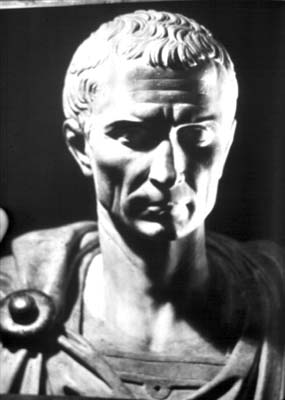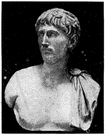Government and Politics of the Roman Empire
By: Marianne Sparan & Donielle Streuli
Roman government revolved around the idea of rule by the people and a sturdy system of checks and balances. Memories of autocratic rulers left Romans with bad memories of what happens when the principles of democracy are compromised during one man's quest for power. Because of this, they were wary, one might even say paranoid, about preventing too much power from reaching the hands of one person. The common people sometimes forgot this, but ambitious nobles didn't let them forget for long, as we can see in Julius Caesar.
The Rise to Power
In this section we will explain the Roman Cursus Honorum as it existed during the Roman Republic, circa 40 BC. The Romans had a pyramid of power that in theory any Roman citizen could ascend. At the lowermost rung of the social/political/economic ladder were the servi (slaves). These men and women were usually conquered people brought back from the provinces, or other barbarians captured by Roman venalicii (slave traders) and sold to citizens. It was very common to own a slave, and almost every respectable citizen did. However, slavery was very often not a permanent state. Kind masters frequently emancipated their slaves for good behavior and they would take on the new position of libertus (freed man). While these freed slaves scarcely made it up to the position of senator or eques, and could only run for office with special permission, it did happen occasionally.
At the next level of the population were the commoners. In keeping with the idea of social mobility, all opportunities would be open to these people, assuming they were male (only men were considered citizens). In order to be considered a plebian one had to own land, but not necessarily have much money. However, government jobs did not have salaries, and large sums of money had to be spent campaigning, so it was almost always wealthy men who ran for office.
This image shows the theoretical rise to power a Roman man could take (starting at the bottom):

About the Various Positions
Tribune(shared by ten men)
Requirements:
-member of the plebian class
-at least 37 years of age
Duties:
-protect the interests of the common people from being harmed by the patricians
Powers:
-could veto any act/proposal of another officer
-could punish other officers, sometimes with death
-could convene the Assembly of the People and the Senate
Special Treatment:
-were regarded as sacrosanct by the people
-It was a capital offense to bring harm to any member of the Tribune
Restrictions:
-sacrosanctity only existed within Rome and one mile surrounding the city
-vetoing powers did not apply to provincial governors
-one year term
Quaestor(shared by 40 men at the time of Julius Caesar, 20 before)
Requirements:
-at least 30 years of age
Duties:
-acted as treasurers; “paymasters of the state”
Powers:
-received all the revenues and paid the salaries of the military, etc.
Special Treatment:
-allowed to wear a toga praetexta(toga with a purple border)
-during Julius Caesar’s rule, this was the job frequently given to his followers as a favor
Restrictions:
-did not receive a lictor(bodyguard)
-one year term
Aedile (plebian/curule)(shared by three men each-one of whom was solely responsible for the food supply)
Requirements:
-elected by the Comitia tribute(assembly of the people)
-plebian was plebian, curule was patrician
-at least 37 years of age
-serve as quaestor beforehand
Duties:
-organize the Roman Games
-take care of water/food supply
-care of the temples and other public buildings
-superintendents of the marketplace
Powers:
-occasionally served as judges in mercantile affairs
Special Treatment:
-allowed to wear a toga praetexta
Restrictions:
-did not receive a lictor
-one year term
Praetor(10 men- originally one, but the number expanded as Rome grew)
Requirements:
-at least 30 years of age
-Plebians had to have been either a member of the tribune or an aedile, but Patricians did not
Duties:
-administration of justice
-paid for the Roman Games
Powers:
-served as the supreme judge
Special Treatment:
-had six lictores
-allowed to wear a toga praetexta
Restrictions:
-one year term
Propraetor
Propraetors had been a praetor the previous year, and had presumably done such a good job that their term was extended and they were now governor of one of the Roman provinces. Their was no limit to how long one could serve in this position, but one had to be a Patrician.
Consul(shared by two men)
Requirements:
-at least 43 years of age
-elected by the Comitia Centuriata
-member of either patrician or plebian class
-must have been a praetor beforehand
Duties:
-responsible for maintaining order in the Roman Republic
-equivalent to a dual-presidency
-a very honorable and important position, but in reality Roans were so afraid of corruption that the consuls had little bona fide power.
Powers:
-chairmen of the senate
-non-tribunal officials answered to them
-introduced legislation
-nominated a dictator
-Commanders-in-Chief of the army if necessary
Special Treatment:
-twelve lictores
-allowed to wear a toga praetexta
-names were included as months in the Roman year
-considered a lifetime member of the senate
Restrictions:
-one year term (re-election was possible, but only if ten years had passed)
-each consul could veto the other one, so they could only rule as a unit
Proconsul
Proconsuls, similar to propraetors, had been a consul the previous year and got their term extended in a province.
Censor(shared by two men- was abolished by Julius Caesar but later restored)
Requirements:
-elected by the Comitia Centuriata
-member of the patrician class
-ex-consul
-at least 43 years of age
Duties:
-took a census of the Roman population
-find farmers for public land
-set up public projects (aqueduct building, etc)
-control of the public moral
Powers:
-could expel Senators
Restrictions:
-elected as needed (usually about every 5 years) for eighteen months
Dictator(one man)
Requirements:
-capable military commander
-Rome was in a state of emergency
-approved by both the people and the Senate
Duties:
-had absolute power over the entire Republic
Special Treatment:
-24 lictores
Restrictions:
-could only serve for six months
LEADERSHIP OF ROME
TARQUINS
The region of Etruria was established in the Northern parts of Italy and was settled by the Etruscans. It is thought that they migrated there from Asia Minor and spoke a completely different language than neighboring people. The Etruscan dynasty of the Tarquins is said to have ruled from 616 to 510 B.C.

This map shows the region of Etruria.
Tarquinius Priscus (Tarquin the Elder) came from the Etruscan city of Tarquinii. With his wife, Tanaquil, he moved to Rome. In Rome, Tarquinius achieved great respect, especially from King Ancus Marcius, who appointed Tarquinius guardian of his sons. After the death of King Ancus, Tarquinius was able to convince the People’s Assembly that he should be elected king.

This coin depicts Tarquinius Priscus
He ruled from 616–579 B.C. as king, Tarquinius was extremely successful. The success of his war campaigns allowed him to bring much capital to Rome. He doubled the size of the People’s Assemble to 1800 people, and added more men to the Senate from the lower classes. He is well known for building the Circus Maximus.

The famous Circus Maximus
He also began the fashion of wearing a robe of gold and purple; and chariots drawn by four horses. Tarquinius was murdered at the instigation of King Ancus Marcius’s sons who felt they had been cheated of their inheritance.

Chariots drawn by four horses, a new method of transportation
Lucius Tarquinius Superbus (Tarquin the Proud) then gained control. Under his rule his power was absolute. The people started to dislike him for his implication of tyranny. In 510 B.C. he was dethroned by the Senate.

Lucius Tarquinius Superbus
TRIUMVIRATES
In 60 B.C. Rome came under the control of its first triumvirate.
A triumvirate is the term used to define three powerful individuals in control of the same area.
The alliance was between Gnaeus Pompeius Magnus (Pompey the Great), Marcus Licinius Crassus (Crassus), and Gaius Julius Caesar.





Pompey Marcus Crassus Julius Caesar
The Beginning of the First Triumvirate
Pompey had led campaigns through Syria Palestine and Asia Minor. After returning to Rome he Senate refused to give land grants to Pompey’s soldiers. So, Pompey went looking for allies, and found Julius Caesar. They both disliked the Senate, Caesar due to his refusal of the spot as consul because Senate feared his popularity.
Crassus was the wealthiest man in Rome; Pompey and Crassus had become popular for repealing part of the constitution.
So, in 60 B.C. Caesar, Crassus, and Pompey pool their resources and form the 1st triumvirate. It was unofficial by legal means.
The three divided the provinces, Crassus received Syria, Pompey received Spain, and Caesar received Gaul and Illryia.

The size of the total Roman Empire at the ending of the first Triumvirate.
The Fall of the Triumvirate
Crassus dies in war in the East 53 B.C. leaving simply Caesar and Pompey. Caesar’s conquests of Gaul and Britain gave him a mass of power. This led Pompey to break off the alliance with Caesar and side himself with the Senate. 49 B.C. Senate ordered Caesar to disband his armies, he refused. Caesar then crushed a final army led by Pompey. This forced Pompey to flee to Egypt, where he was assassinated by orders of King Ptolemy. Then, in 47 B.C. Caesar had sole leadership of Rome.

A great description of the first Triumvirate
The Beginning of the Second Triumvirate

The murder of Julius Caesar was the direct precursor of the
Second Roman Triumvirate.
Caesar’s murder directly led to the 2nd triumvirate of Rome. Which began in 43 B.C. and lasted until 33 B.C.
Caesar’s 18 year old grand-nephew, Octavian, aligned with Mark Antony and Marcus Lepidus; Caesar’s chief generals. Marcus Lepidus was also consul of Rome.



Octavian Mark Antony Marcus Lepidus
Octavian and Antony defeated the republicans at Philippi, which gave the three official control of Rome.

This map highlights the city of Philippi, where Octavian and Mark
Antony defeated the republicans, and thus gaining power of Rome.
This triumvirate also split their areas of reign. Antony received the East, Lepidus received North Africa, and Octavian received Italy, the West, and Gaul.

This map highlights the areas under
Roman control at the time of the
second Triumvirate.
In 33 B.C. Octavian is elected consul. Lepidus was forced to give up his position after he tried to get troops to mutiny against Caesar. Yet, when Mark Antony married Queen Cleopatra VII of Egypt, Octavian feared they would gain power. Octavian convinces the Senate that Antony is planning to separate from the Empire, and Octavian sets Egypt under attack. The next year Octavian controlled Egypt, making him the first sole ruler of a unified Rome.

Queen Cleopatra VII
Works Consulted
Haslall, Paul. Ancient History Sourcebook. 2000. Fordham University. 2 May 2009 <http://www.fordham.edu/halsall/ancient/rome-balance.html>.
Lendering, Jona. "Cursus Honoram." Livius- Articles on Ancient History. 2009. 2 May 2009 <http://www.livius.org/ct-cz/cursus/cursus_honorum.html>.
McManus, Barbara F. Roman Cursus Honoram. 2003. The College of New Rochelle. 2 May 2009 <http://www.vroma.org/~bmcmanus/romangvt.html>
Ancient Rome. 2009 Microsoft
Encarta Online Encyclopedia 2009.
18 April. 2009
<http://encarta.msn.com/encyclopedia_761552589/Ancient_Rome.html>
Beers, Burton F. World History Patterns of Civilization. Englewood Cliffs, New Jersey:
Prentice Hall A Division of Simon & Schuster, 1993.
Berndl, Klaus, Markus Hattstein, Arthur Knebel, Hermann-Josef Udelhoven. National
Geographic Visual History of the World. Berlin: Peter Delius Verlag GmbH & Co. KG, 2005
“First Triumvirate.” Wikipedia: The Free Encyclopedia.
3 May 2009.
20 April 2009
<http://en.wikipedia.org/wiki/First_Triumvirate>
“Lucius Tarquinius Priscus” Wikipedia: The Free Encylopedia.
22 April 2009
18 April 2009
<http://en.wikipedia.org/wiki/Tarquin_the_Elder>
“Second Triumvirate.” Wikipedia: The Free Encyclopedia.
27 April 2009
20 April 2009.
<http://en.wikipedia.org/wiki/Second_Triumvirate>.
"Tarquin." Encyclopædia Britannica. 2009.
Encyclopædia Britannica Online.
18 April. 2009
<http://www.britannica.com/EBchecked/topic/583663/Tarquin>.
Comments (0)
You don't have permission to comment on this page.